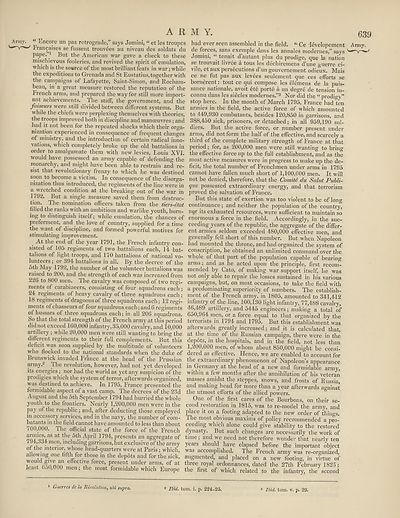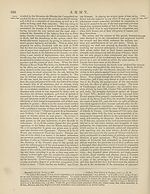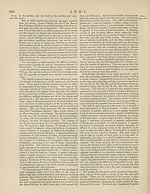Encyclopaedia Britannica > Volume 3, Anatomy-Astronomy
(647) Page 639
Download files
Complete book:
Individual page:
Thumbnail gallery: Grid view | List view

A 11
Arm)-. “ Encore un pas retrograde,” says Jomini, “ et les troupes
EranRaises se fussent trouvees au niveau des soldats du
PaPe-”1 But the American war gave a check to these
mischievous fooleries, and revived the spirit of emulation,
which is the source of the most brilliant feats in war; while
the expeditions to Grenada and St Eustatius, together with
the campaigns of Lafayette, Saint-Simon, and Rocham-
beau, in a great measure restored the reputation of the
french arms, and prepared the way for still more import¬
ant achievements. The staff, the government, and the
faiseurs were still divided between different systems. But
while the chiefs were perplexing themselves with theories,
the troops improved both in discipline and manoeuvres; and
had it not been for the repeated shocks which their orga¬
nization experienced in consequence of frequent changes
of ministry, and the introduction of certain radical inno¬
vations, which completely broke up the old battalions in
order to amalgamate them with new levies, Louis XVI.
would have possessed an army capable of defending the
monarchy, and might have been able to restrain and re¬
sist that revolutionary frenzy to which he Mas destined
soon to become a victim. In consequence of the disorga¬
nization thus introduced, the regiments of the line were in
a wretched condition at the breaking out of the war in
1792. But a single measure saved them from destruc¬
tion. The nomination officers taken from the tiers-etat
filled the ranks with an ambitious and warlike youth, burn¬
ing to distinguish itself; while emulation, the chances of
preferment, and the love of country, supplied for a time
the M'ant of discipline, and formed powerful motives for
stimulating improvement.
At the end of the year 1791, the French infantry con¬
sisted of 105 regiments of two battalions each, 14 bat¬
talions of light troops, and 170 battalions of national vo¬
lunteers ; or 394 battalions in all. By the decree of the
5th May 1792, the number of the volunteer battalions was
raised to 200, and the strength of each was increased from
226 to 800 men. The cavalry was composed of two regi¬
ments of carabineers, consisting of four squadrons each ;
24 regiments of heavy cavalry of three squadrons each;
18 regiments of dragoons of three squadrons each; 12 regi¬
ments of chasseurs of four squadrons each; and6 regiments
of hussars of three squadrons each; in all 206 squadrons.
8o that the total strength of the French army at this period
did not exceed 160,000 infantry, 35,000 cavalry, and 10,000
artillery; while 20,000 men were still wanting to bring the
different regiments to their full complements. But this
deficit was soon supplied by the multitude of volunteers
who flocked to the national standards when the duke of
Brunswick invaded France at the head of the Prussian
army.2 The revolution, however, had not yet developed
its energies ; nor had the Mrorld as yet any suspicion of the
prodigies which the system of terror, afterwards organized,
was destined to achieve. In 1795, France presented the
formidable aspect of a vast camp. The decrees of the 23d
August and the 5th September 1794 had hurried the whole
youth to the frontiers. Nearly 1,200,000 men M'ere in the
pay of the republic ; and, after deducting those employed
in accessory services, and in the navy, the number of com¬
batants in the field cannot have amounted to less than about
/00,000. Ihe official state of the force of the French
armies, as at the 5th April 1794, presents an aggregate of
794,334 men, including garrisons, but exclusive of the army
of the interior, whose head-quarters were at Paris ; which,
allowing one fifth for those in the depots and for the sick,
would give an effective force, present under arms, of at
least 650,000 men; the most formidable which Europe
M Y. 639
had ever seen assembled in the field. “ Ce dev elopement Army.
de forces, sans exemple dans les annales modernes,” says
Jomini, “ tenait d autant plus du prodige, que la nation
se trouvait livree a tous les dechiremens d’une guerre ci¬
vile, et aux persecutions d’un gouvernement odieux. Mais
ce ne fut pas aux levees seulement que ces efforts se
bornerent: tout ce qui compose les elemens de la puis¬
sance nationale, avoit etc porte a un degre de tension in-
connu dans les siecles modernes.”3 Nor did the “ prodigy”
stop here. In the month of March 1795, France had^en
armies in the field, the active force of which amounted
to 449,930 combatants, besides 120,850 in garrisons, and
388,450 sick, prisoners, or detached; in all 959,190 sol¬
diers. But the active force, or number present under
arms, did not form the half of the effective, and scarcely a
third of the complete military strength of France at that
period; for, as 200,000 men were still wanting to bring
the effective force up to the full establishment, and as the
most active measures were in progress to make up the de¬
ficit, the total number of Frenchmen under arms in 1795
cannot have fallen much short of 1,100,000 men. It M'ill
not be denied, therefore, that the Comite du Saint Publi-
que possessed extraordinary energy, and that terrorism
proved the salvation of France.
But this state of exertion was too violent to be of long
continuance; and neither the population of the country,
nor its exhausted resources, were sufficient to maintain so
enormous a force in the field. Accordingly, in the suc¬
ceeding years of the republic, the aggregate of the differ¬
ent armies seldom exceeded 480,000 effective men, and
generally fell short of this number. But when Napoleon
had mounted the throne, and had organized the system of
conscription, he obtained an unlimited command over the
whole of that part of the population capable of bearing
arms; and as he acted upon the principle, first recom¬
mended by Cato, of making war support itself, he was
not only able to repair the losses sustained in his various
campaigns, but, on most occasions, to take the field with
a predominating superiority of numbers. The establish¬
ment of the trench army, in 1805, amounted to 341,412
infantry of the line, 100,130 light infantry, 77,488 cavalry,
46,489 artillery, and 5445 engineers; making a total of
650,964 men, or a force equal to that organized by the
terrorists in 1794 and 1795. But this establishment was
afterwards greatly increased; and it is calculated that,
at the time of the Russian campaign, there were in the
depots, in the hospitals, and in the field, not less than
1,200,000 men, of whom about 850,000 might be consi¬
dered as effective. Hence, we are enabled to account for
the extraordinary phenomenon of Napoleon’s appearance
in. Germany at the head of a new and formidable army,
within a few months after the annihilation of his veteran
masses amidst the steppes, snows, and frosts of Russia,
and making head for more than a year aftemards against
the utmost efforts of the allied powers.
One of the first cares of the Bourbons, on their se¬
cond icstoration in 1815, was to re-model the army, and
place it on a footing adapted to the new order of things.
Ihe .most obvious maxims of policy recommended a pro¬
ceeding which alone could give stability to the restored
dynasty. ^ But such changes are necessarily the work of
time; anci we need not therefore wonder that nearly ten
years should have elapsed before the important object
was accomplished. The French army was re-organized,
augmented, and placed on a new footing, in virtue of
three royal ordonnances, dated the 27th February 1825;
the first of M'hich related to the infantry, the second
* Gucrrcs dc In liccolutioiiy ubi supra.
2 Ibid. tom. i. p. 224-25.
3 Ibid. tom. v. p. 29.
Arm)-. “ Encore un pas retrograde,” says Jomini, “ et les troupes
EranRaises se fussent trouvees au niveau des soldats du
PaPe-”1 But the American war gave a check to these
mischievous fooleries, and revived the spirit of emulation,
which is the source of the most brilliant feats in war; while
the expeditions to Grenada and St Eustatius, together with
the campaigns of Lafayette, Saint-Simon, and Rocham-
beau, in a great measure restored the reputation of the
french arms, and prepared the way for still more import¬
ant achievements. The staff, the government, and the
faiseurs were still divided between different systems. But
while the chiefs were perplexing themselves with theories,
the troops improved both in discipline and manoeuvres; and
had it not been for the repeated shocks which their orga¬
nization experienced in consequence of frequent changes
of ministry, and the introduction of certain radical inno¬
vations, which completely broke up the old battalions in
order to amalgamate them with new levies, Louis XVI.
would have possessed an army capable of defending the
monarchy, and might have been able to restrain and re¬
sist that revolutionary frenzy to which he Mas destined
soon to become a victim. In consequence of the disorga¬
nization thus introduced, the regiments of the line were in
a wretched condition at the breaking out of the war in
1792. But a single measure saved them from destruc¬
tion. The nomination officers taken from the tiers-etat
filled the ranks with an ambitious and warlike youth, burn¬
ing to distinguish itself; while emulation, the chances of
preferment, and the love of country, supplied for a time
the M'ant of discipline, and formed powerful motives for
stimulating improvement.
At the end of the year 1791, the French infantry con¬
sisted of 105 regiments of two battalions each, 14 bat¬
talions of light troops, and 170 battalions of national vo¬
lunteers ; or 394 battalions in all. By the decree of the
5th May 1792, the number of the volunteer battalions was
raised to 200, and the strength of each was increased from
226 to 800 men. The cavalry was composed of two regi¬
ments of carabineers, consisting of four squadrons each ;
24 regiments of heavy cavalry of three squadrons each;
18 regiments of dragoons of three squadrons each; 12 regi¬
ments of chasseurs of four squadrons each; and6 regiments
of hussars of three squadrons each; in all 206 squadrons.
8o that the total strength of the French army at this period
did not exceed 160,000 infantry, 35,000 cavalry, and 10,000
artillery; while 20,000 men were still wanting to bring the
different regiments to their full complements. But this
deficit was soon supplied by the multitude of volunteers
who flocked to the national standards when the duke of
Brunswick invaded France at the head of the Prussian
army.2 The revolution, however, had not yet developed
its energies ; nor had the Mrorld as yet any suspicion of the
prodigies which the system of terror, afterwards organized,
was destined to achieve. In 1795, France presented the
formidable aspect of a vast camp. The decrees of the 23d
August and the 5th September 1794 had hurried the whole
youth to the frontiers. Nearly 1,200,000 men M'ere in the
pay of the republic ; and, after deducting those employed
in accessory services, and in the navy, the number of com¬
batants in the field cannot have amounted to less than about
/00,000. Ihe official state of the force of the French
armies, as at the 5th April 1794, presents an aggregate of
794,334 men, including garrisons, but exclusive of the army
of the interior, whose head-quarters were at Paris ; which,
allowing one fifth for those in the depots and for the sick,
would give an effective force, present under arms, of at
least 650,000 men; the most formidable which Europe
M Y. 639
had ever seen assembled in the field. “ Ce dev elopement Army.
de forces, sans exemple dans les annales modernes,” says
Jomini, “ tenait d autant plus du prodige, que la nation
se trouvait livree a tous les dechiremens d’une guerre ci¬
vile, et aux persecutions d’un gouvernement odieux. Mais
ce ne fut pas aux levees seulement que ces efforts se
bornerent: tout ce qui compose les elemens de la puis¬
sance nationale, avoit etc porte a un degre de tension in-
connu dans les siecles modernes.”3 Nor did the “ prodigy”
stop here. In the month of March 1795, France had^en
armies in the field, the active force of which amounted
to 449,930 combatants, besides 120,850 in garrisons, and
388,450 sick, prisoners, or detached; in all 959,190 sol¬
diers. But the active force, or number present under
arms, did not form the half of the effective, and scarcely a
third of the complete military strength of France at that
period; for, as 200,000 men were still wanting to bring
the effective force up to the full establishment, and as the
most active measures were in progress to make up the de¬
ficit, the total number of Frenchmen under arms in 1795
cannot have fallen much short of 1,100,000 men. It M'ill
not be denied, therefore, that the Comite du Saint Publi-
que possessed extraordinary energy, and that terrorism
proved the salvation of France.
But this state of exertion was too violent to be of long
continuance; and neither the population of the country,
nor its exhausted resources, were sufficient to maintain so
enormous a force in the field. Accordingly, in the suc¬
ceeding years of the republic, the aggregate of the differ¬
ent armies seldom exceeded 480,000 effective men, and
generally fell short of this number. But when Napoleon
had mounted the throne, and had organized the system of
conscription, he obtained an unlimited command over the
whole of that part of the population capable of bearing
arms; and as he acted upon the principle, first recom¬
mended by Cato, of making war support itself, he was
not only able to repair the losses sustained in his various
campaigns, but, on most occasions, to take the field with
a predominating superiority of numbers. The establish¬
ment of the trench army, in 1805, amounted to 341,412
infantry of the line, 100,130 light infantry, 77,488 cavalry,
46,489 artillery, and 5445 engineers; making a total of
650,964 men, or a force equal to that organized by the
terrorists in 1794 and 1795. But this establishment was
afterwards greatly increased; and it is calculated that,
at the time of the Russian campaign, there were in the
depots, in the hospitals, and in the field, not less than
1,200,000 men, of whom about 850,000 might be consi¬
dered as effective. Hence, we are enabled to account for
the extraordinary phenomenon of Napoleon’s appearance
in. Germany at the head of a new and formidable army,
within a few months after the annihilation of his veteran
masses amidst the steppes, snows, and frosts of Russia,
and making head for more than a year aftemards against
the utmost efforts of the allied powers.
One of the first cares of the Bourbons, on their se¬
cond icstoration in 1815, was to re-model the army, and
place it on a footing adapted to the new order of things.
Ihe .most obvious maxims of policy recommended a pro¬
ceeding which alone could give stability to the restored
dynasty. ^ But such changes are necessarily the work of
time; anci we need not therefore wonder that nearly ten
years should have elapsed before the important object
was accomplished. The French army was re-organized,
augmented, and placed on a new footing, in virtue of
three royal ordonnances, dated the 27th February 1825;
the first of M'hich related to the infantry, the second
* Gucrrcs dc In liccolutioiiy ubi supra.
2 Ibid. tom. i. p. 224-25.
3 Ibid. tom. v. p. 29.
Set display mode to:
![]() Universal Viewer |
Universal Viewer | ![]() Mirador |
Large image | Transcription
Mirador |
Large image | Transcription
Images and transcriptions on this page, including medium image downloads, may be used under the Creative Commons Attribution 4.0 International Licence unless otherwise stated. ![]()
| Encyclopaedia Britannica > Encyclopaedia Britannica > Volume 3, Anatomy-Astronomy > (647) Page 639 |
|---|
| Permanent URL | https://digital.nls.uk/193765759 |
|---|
| Attribution and copyright: |
|
|---|---|
| Shelfmark | EB.16 |
|---|---|
| Description | Ten editions of 'Encyclopaedia Britannica', issued from 1768-1903, in 231 volumes. Originally issued in 100 weekly parts (3 volumes) between 1768 and 1771 by publishers: Colin Macfarquhar and Andrew Bell (Edinburgh); editor: William Smellie: engraver: Andrew Bell. Expanded editions in the 19th century featured more volumes and contributions from leading experts in their fields. Managed and published in Edinburgh up to the 9th edition (25 volumes, from 1875-1889); the 10th edition (1902-1903) re-issued the 9th edition, with 11 supplementary volumes. |
|---|---|
| Additional NLS resources: |
|

